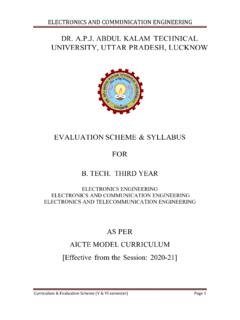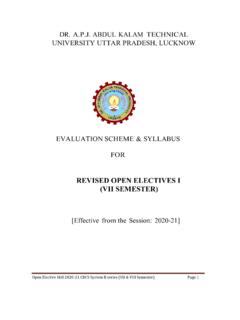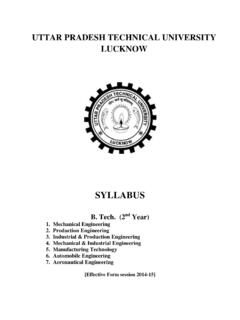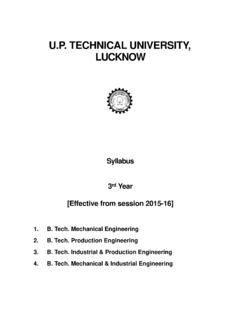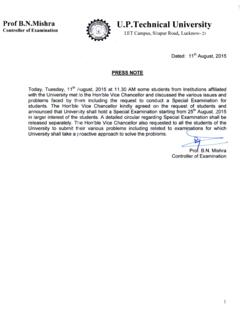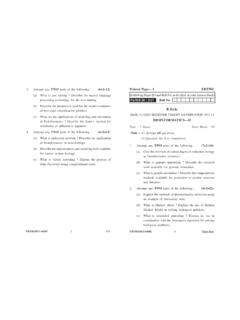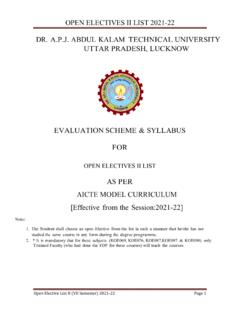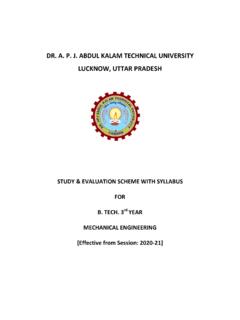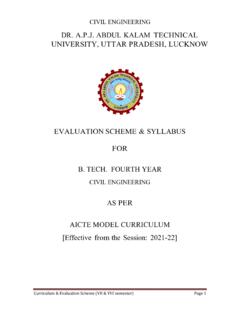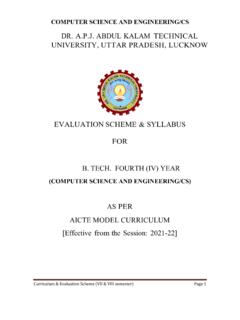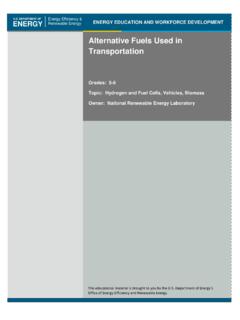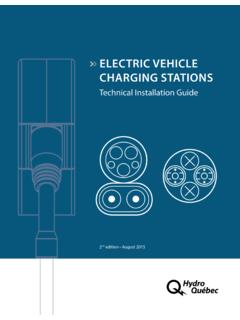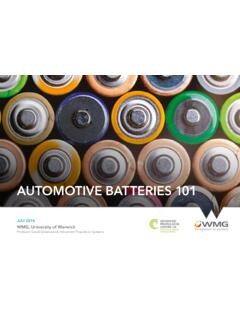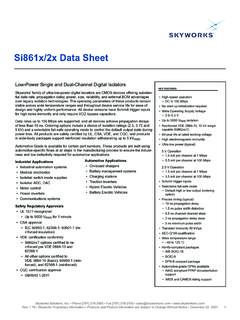Transcription of DR. A.P.J. ABDUL KALAM TECHNICAL UNIVERSITY, UTTAR …
1 Curr ELEC riculum & EvaDUNIVEELECCTRIC aluation SchDR. [EffeAL & Eeme EN (VII .J. ABDITY, UTUATIOB. TECHAL & ECTE MOective fr ELECT& VIII semesDUL KTTAR N SCHFOH. FouELECTOODEL rom theRONIC ster) KALAMPRADE HEME &OR rth (IVRONIC ON CURRe SessioCS ENGM TECHESH, L & SYLV) YEARCS ENGRICULUon: 202 GINEERPagHNICALUCKNLABUR GINEERUM) 1-22] RING ge 1 AL NOW S RING ELECTRICAL & ELECTRONICS ENGINEERING Curriculum & Evaluation Scheme EN (VII & VIII semester) Page 2 ELECTRICAL & ELECTRONICS ENGINEERING EVALUATION SCHEME - 4th YEAR SEMESTER- VII Sl. No. Subject Codes Subject Periods Evaluation Scheme End Semester Total Credit L T P CT TA Total PS TE PE 1 KHU701/KHU702 HSMC -1 #/ HSMC-2 # 3 0 0 30 20 50 100 150 3 2 KEE07X Departmental Elective-IV 3 0 0 30 20 50 100 150 3 3 KEE07X Departmental Elective-V 3 0 0 30 20 50 100 150 3 4 KOE07X Open
2 Elective-II 3 0 0 30 20 50 100 150 3 5 KEN751 Industrial Automation & PLC Lab 0 0 2 25 25 50 1 6 KEN752 Mini Project or Internship Assessment* 0 0 2 50 50 1 7 KEN753 Project I 0 0 8 150 150 4 8 MOOCs (Essential for Hons. Degree) TOTAL 12 0 12 850 18 *The Mini Project or internship (4 - 6 weeks) conducted during summer break after VI semester and will be assessed during VII semester.
3 Department Elective - IV KEN070: power System Operation & Control KEE070: Advanced Micro processors & Micro Controllers KEE071: Energy Conservation and Auditing KEE072: HVDC & AC Transmission KEE074: power Quality and FACT Department Elective - V KEN071: Electric & hybrid Vehicles KEE075: Electric drives KEE077: power System Protection KEE078: Deregulated power System KEE079: Utilization of Electrical Energy & Electric Traction SEMESTER- VIII Sl. No. Subject Codes Subject Periods Evaluation Scheme End Semester Total Credit L T P CT TA Total PS TE PE 1 KHU801/KHU802 HSMC-2#/HSMC-1# 3 0 0 30 20 50 100 150 3 2 KOE08X Open Elective-III 3 0 0 30 20 50 100 150 3 3 KOE08X Open Elective-IV 3 0 0 30 20 50 100 150 3 4 KEN851 Project II 0 0 18 100 300 400 9 5
4 MOOCs (Essential for Hons. Degree) Total 9 0 18 850 18 ELECTRICAL & ELECTRONICS ENGINEERING Curriculum & Evaluation Scheme EN (VII & VIII semester) Page 3 INDUSTRIAL AUTOMATION & PLC LAB [L T P: 0 0 2] List of Experiments: minimum 10 nos. of experiments to be performed from following sets, A) Industrial Automation: 1. Study hardware and software platforms for DCS 2. Simulate analog and digital function blocks 3. Study, understand and perform experiments on timers and counters 4. Logic implementation for traffic Control Application 5.
5 Logic implementation for Bottle Filling Application 6. Tune PID controller for heat exchanger using DCS 7. FBD for auto-clavable laboratory fermenter 8. Develop graphical user interface for the fermenter plant B) PLC 1. Study hardware and software used in PLC 2. Implementation Logic Gates 3. Implementation of DOL Starter 4. Implementation of On-Delay Timer 5. Implementation of Off-Delay Timer 6. Implementation of Up-Down Counter 7. Implementation of PLC Arithmetic Instructions 8. Implementation of PID Controller Note: - virtual lab links: For Industrial Automation: For PLC: ELECTRICAL & ELECTRONICS ENGINEERING Curriculum & Evaluation Scheme EN (VII & VIII semester) Page 4 DEPARTMENT ELECTIVE IV [L T P: 3 0 0] ELECTRICAL & ELECTRONICS ENGINEERING Curriculum & Evaluation Scheme EN (VII & VIII semester) Page 5 power SYSTEM OPERATION & CONTROL Pre-requisites of the course: power System-I, power System-II Course Outcome Knowledge Level Upon the completion of the course, the student will be able to.
6 CO1 Describe the significance of power System Operation and Control. K1 CO2 Describe Real power -frequency interaction and explicate the concept of designing a power -frequency controller. K2 CO3 Illustrate Reactive power -voltage interaction and the control actions to be implemented for maintaining the voltage profile against varying system load. K3 CO4 Determine the necessary variables for an operating state to obtain the economic operation. K3 CO5 Describe power system security and identification of Linear and non-linear models K2 UNIT-I: Introduction: Structure of power systems, significance of voltage and frequency control.
7 power system control center and real time computer control, SCADA and EMS functions, system monitoring- RTU, PMU- concept of synchrophasor, data acquisition and controls. power scenario in Indian grid, National and Regional load dispatching centers UNIT-II: Load Frequency Control: Concept of load frequency control, Load frequency control of single area system: Turbine speed governing system and modeling, block diagram representation of single area system, steady state analysis, dynamic response, control area concept, P-I control, load frequency control and economic dispatch control.
8 Load frequency control of two area system: Tie line power modeling, block diagram representation of two area system, static and dynamic response UNIT-III: Automatic Voltage Control: Schematic diagram and block diagram representation, different types of Excitation systems & their controllers, static and dynamic analysis of AVR Voltage and Reactive power control: Concept of voltage control, methods of voltage control by tap changing transformer. Shunt Compensation, series compensation, phase angle compensation, concept of voltage stability in power system UNIT-IV.
9 Economic Operation of power System- Concept and problems of unit commitment Input-output characteristics of thermal and hydro-plants System constraints, optimal operation of thermal units without and with transmission losses (no derivation of transmission loss coefficients), penalty factor, incremental transmission loss, Hydrothermal scheduling long and short terms, Concept of optimal power flow, Formulation Unit V: power System Security- Three state model, operating states, state transition, Distribution factors- Generation Shift Distribution Factor, Outage Distribution Factor- Derivation through DC load flow State Estimation: Detection and identification, Linear and non-linear models.
10 Text Books: 1. Kothari & Nagrath, Modern power System Analysis Mc Graw Hill, 3rd Edition. 2. Murty, Operation and control in power Systems Publications. ELECTRICAL & ELECTRONICS ENGINEERING Curriculum & Evaluation Scheme EN (VII & VIII semester) Page 6 3. Olle. I. Elgerd, Electric Energy systems theory- An Introduction , Tata Mc Graw Hill publishing Ltd, New Delhi, 2008 4. A. J. Wood & Wollenburg, power Generation, Operation and Control John Wiley & Sons. Reference Books: 1. P. Kundur, power System Stability and Control Mc Graw Hill.
